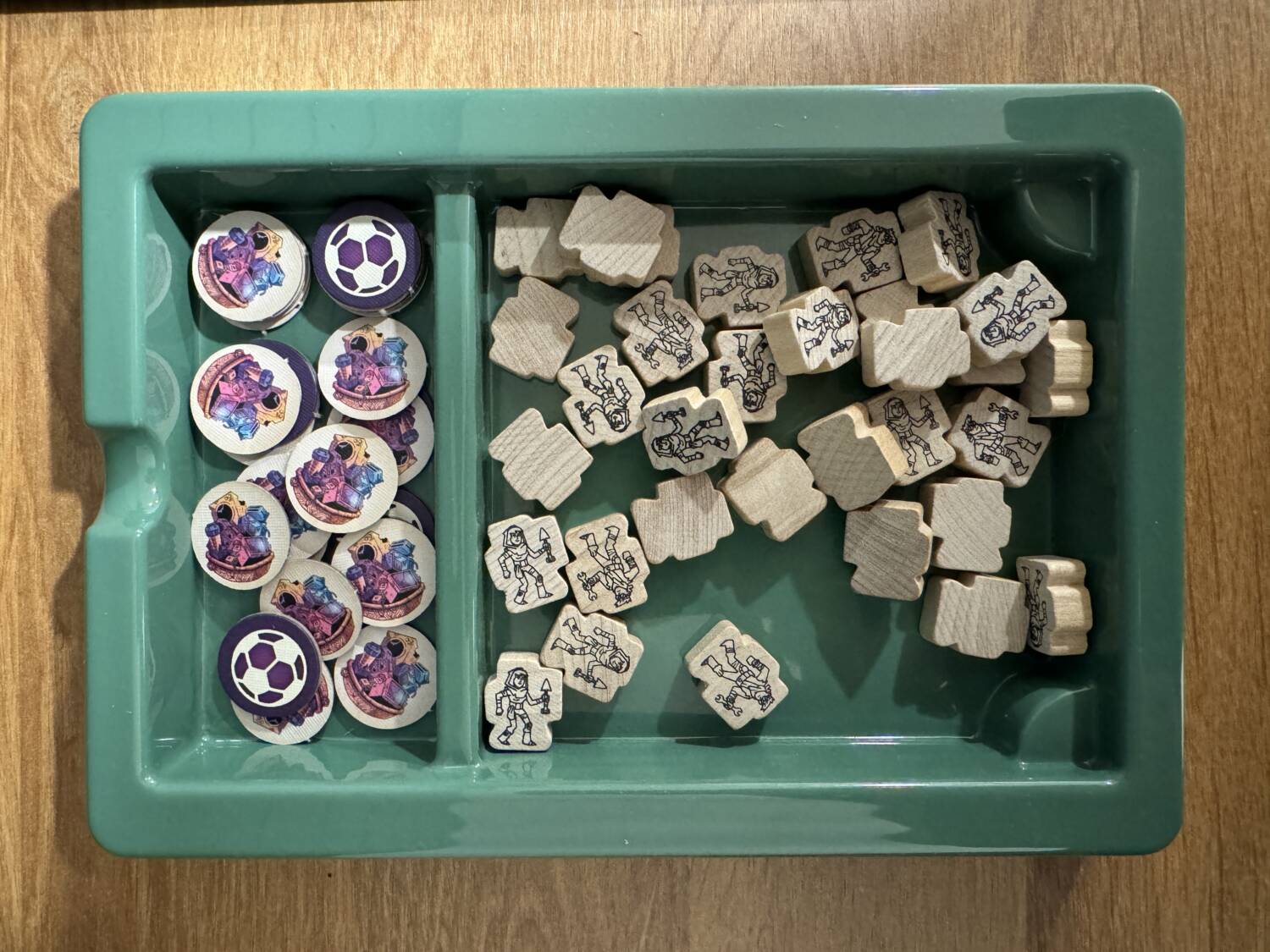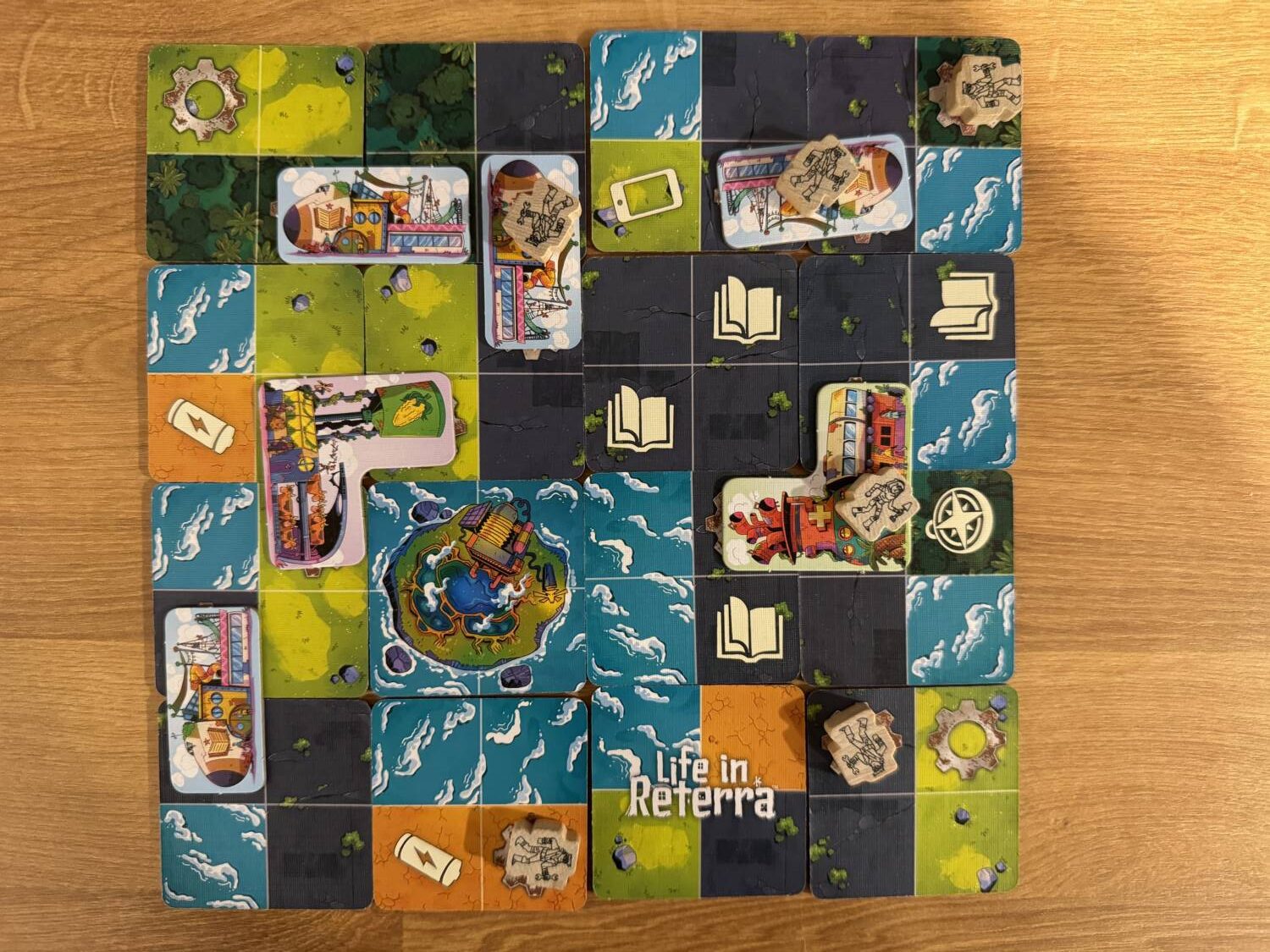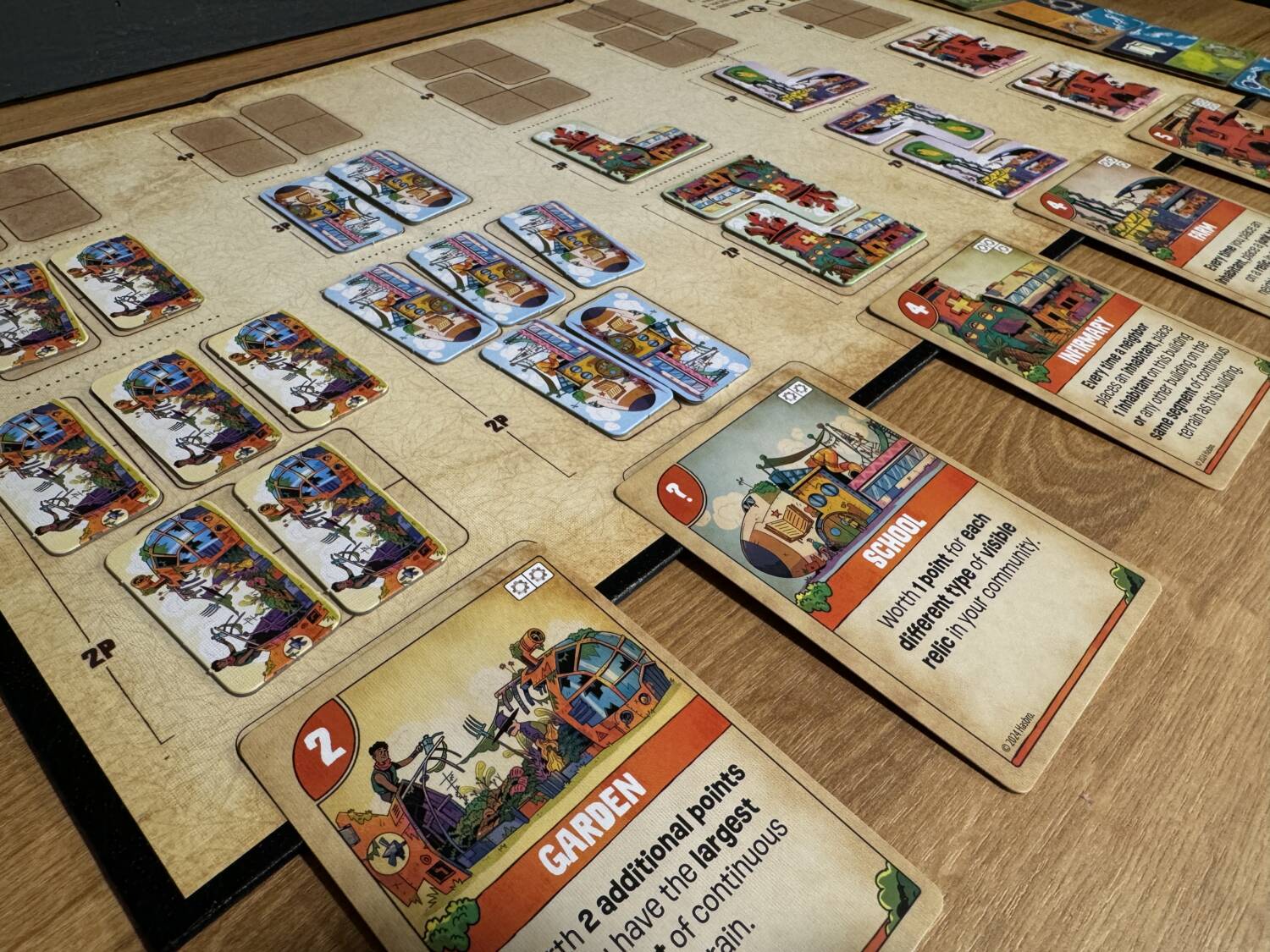Disclosure: Meeple Mountain received a free copy of this product in exchange for an honest, unbiased review. This review is not intended to be an endorsement.
Reclamation themes are commonly explored throughout the media we consume. Whether it is presented in a mysterious way like Lost, or through a lens of inevitability during a post-apocalyptic story like I am Legend, there’s always a hearty contrast between the power of nature and the desire of humanity to endure. In Life in Reterra, the latest game from designers Ken Gruhl and Eric Lang, you are tasked with building up a community from the remnants of the past.
Life in Reterra Overview
There aren’t any life-threatening zombies on Reterra, although the other players may serve as threats to the livability of your community. In Life in Reterra, players will be placing tiles in a 4×4 grid in order to line up gear symbols and match terrain types. Gear symbols allow you to place buildings, thus adding a means for scoring and areas of interest for your community’s inhabitants.
Each game features 5 different building cards, which can be mixed and matched to foster a gaming experience that is suitable for your group. Since these are also double-sided, there are thousands of combinations of buildings to play with. Some of these buildings offer more take-that mechanics that impact other players, and some grant a more peaceful, solitaire-like experience.
After setting up the buildings and the public market of 5 tiles, each player gets a random tile to start their community with. Even though they are all different, they all feature four unique terrain types so everybody is really on equal footing to start. Players also get 3 secret tiles that they can use in lieu of taking a tile from the market. Be warned, however — these secret tiles are never replenished, so use them wisely.
On a player’s turn, they choose either a tile from the market or their secret tile, and place it into their community touching an existing tile. The Kingdomino vibes are real. Then, they can either place an inhabitant on the just-placed tile, or place a building on the tile. The choice can sometimes be agonizing because of the building restrictions, and you are sometimes gambling that you’ll be able to finish a larger building.
Buildings can only be placed on gear icons that have matching terrain and they occupy 2-4 spaces depending on the specific tile. They are also limited in number, scaled based on the player count, so they are a finite resource. You can see the supply dwindling, which also helps show what people are going after without paying too close attention to everybody’s boards.

The other symbol that you’ll find on the tiles are relics. These come in many designs but functionally have the same effect as giving you an extra point during scoring. Be wary of junk tokens, however, as those can negate the bonus from a relic and also count as negative points in their own right.
There are also energy source tiles that are essentially all water with an island in the middle. These count as water tiles for matching terrain, but only score if they are completely surrounded by land tiles and not on the edge of your grid.
Final scoring is a summation of several factors. For every continuous block of matching terrain that’s at least 7 spaces you earn 3 points. Landlocked energy sources are the aforementioned 8 points. Visible relics and inhabitants are 1 point apiece. Buildings are scored based on their individual point value plus any modifiers — many buildings award bonus points if certain criteria are met. Lastly, subtract a point for each piece of junk in your community. Highest score wins.

Life in Reterra: Options Galore
I was immediately impressed with the quality of the game for its price point of $30. There are four beautifully organized trays with textured lids to house the three base groups of building tiles and their associated cards along with a tray for the inhabitants and tokens. The building tiles feel thinner than I would expect, but I’m actually okay with the tradeoff to have improved functionality with the trays. I also appreciate that there’s a game board included to provide a roadmap detailing how many of each building to use with each player count. This is a component that certainly isn’t necessary for the game and yet it improves the presentation considerably.
The rulebook for Life in Reterra is written in a conversational tone, clearly as an attempt to appeal to the gateway gamers that they hope to attract. It’s an interesting juxtaposition because I feel like the game is more of a bridge than a true gateway. Bridge games are those that connect entry-level games to more complicated variations of the same mechanics.
I can see the arguments for why this game is in the conversation for being a gateway. The core gameplay loop of take a tile, place a tile is easily approachable. What gives me pause is that the game is strategically much more complex than it appears on its face because of the considerations that you have to make on your turn.
You’re weighing which tile to take — each of which has four spaces for terrain types — and where you would place it, its orientation, the current position of gears on your grid, and which buildings you want to pursue. There’s a bell curve of complexity in your turn that reaches its peak at the midgame before tapering off. The decision space makes this a thinker’s game and it is easy to get lost in analysis land with signposts pointing in a mishmash of directions.
Replayability is a buzzword that gets frequently thrown around, and I will admit that there is enough content in the box to last you for a long while. I appreciate that the designers have provided a sample list of building combinations that can help cater the experience to have games with more interactivity, games that promote inhabitants or relics, and games that are more of a solitary endeavor.
There are some balancing issues with some buildings that make them seem way better than the others. For example, the Inn is a 3-space building that allows you to place an inhabitant on an empty space surrounding the building at the end of each turn, making an early Inn worth 9 points. In contrast, the baseline for building values seems to be around 4 or 5 if you manage to hit its bonus. Of course, the ceiling for the Inn’s max value depreciates as the game progresses, but it still feels much more powerful than many of the others.
Despite the building scoring disparity, I do appreciate how different sets of buildings can drastically change the end-result of your grid. Games with more interactivity will often result in lower overall scores because of the additive effect of covering a relic with a junk token, so those games become a test of who can weather the storm of junk most effectively. You can also succeed in having fewer buildings if you opt to focus on matching terrain groups.
All of this open-endedness is a boon for strategy lovers but it’s also a detriment to those coming into the game thinking that it’s more of a walk in the park. You have access to 8 different tiles at the beginning of the game and that alone can be enough to give pause about what you want to do initially. Basically you’re taking Kingdomino but exponentially increasing the possibilities by doubling the number of terrain on the tile.

Life in Reterra: Building on a Budget
What makes Life in Reterra a solid game is that it makes you feel like you’re playing several games in one. I found myself visually segmenting my board and planning ahead on what I imagined the future state of what the grid would look like. It’s easy to also pick a strategy at the beginning of the game and execute on it. For example, one game I focused on chaining Restaurants together on one giant continuous block of terrain, since they get bonus points for each restaurant atop the same block. Going into the game, that was my goal and I really didn’t have to deviate from that mission.
Before my first play, I thought that buildings were going to be way too easy to get out on the board, but I was incorrect. By requiring gear icons to have matching terrain they become more of a novelty. Most of the time I found myself wanting to build as many 2-tile buildings as possible, because it seems like you get the most bang for your buck that way. Until you factor in the overpowered buildings, that is.
Although I really appreciate that all I have to do on my turn is pick and place a tile, it feels like the decision-making overhead is too high for my expectations. I’d advise adjusting your expectations of what Life in Reterra is before assuming it’s a carefree game. You can agonize over every choice but I’d much rather go into the game knowing that my decisions are going to be suboptimal. Playing with that mindset from the onset is more conducive to me enjoying myself with games like this.
Life in Reterra impresses with its production quality and you’d be hard-pressed to find a game of similar quality at such an attractive price point. There’s just a little too much thinking involved with rebuilding civilization from the ground up.











Add Comment